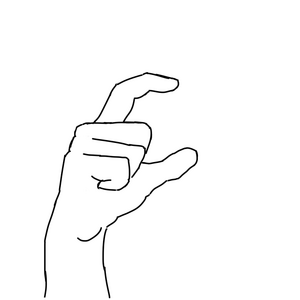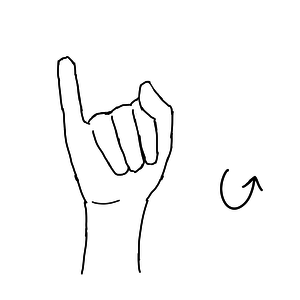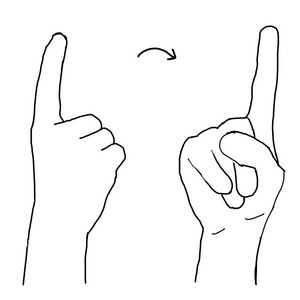Polish Sign Language/Alphabet
The letters of the PJM alphabet are usually signed with the dominant hand, near the signer's shoulder with the palm facing the viewer. The letters can be signed in different positions to accommodate the listener. It is possible to sign with one's non-dominant hand as long as the person stays consistent.

All the letters are presented as the looker would see them with the signer using the right hand.

In this wikibook words which are spelled using the PJM alphabet will be marked by hyphens:
P-J-M

Most letters are static, while others are accompanied by specific movements. Letters with Polish diacritics are always accompanied by some sort of movement.
Letters
[edit | edit source] |
 |
 |
 |
 |
||
 |
 |
|||||
 |
 |
|||||
A
[edit | edit source]
Make a fist, palm facing forward. Keep your thumb next to the index finger.
B
[edit | edit source]
Extend your fingers so that they touch one another, palm facing forward.
C
[edit | edit source]
Make a "C" shape with your index finger and your thumb while keeping other fingers closed.
D
[edit | edit source]This is a dynamic sign.
First, make a fist and extend your index finger, back of the hand facing forward. Then twist your hand so that your palm faces forward.
E
[edit | edit source]F
[edit | edit source]G
[edit | edit source]H
[edit | edit source]I
[edit | edit source]
Make a fist and extend your pinkie.
J
[edit | edit source]
Make a letter I and move your hand to the left writing a "J" in the air.
K
[edit | edit source]L
[edit | edit source]Make an "L" with your thumb and index fingers.
M
[edit | edit source]
Palm facing to the side. Fingers bent so that the tips point to the side.
N
[edit | edit source]O
[edit | edit source]Form an "O" with your index finger and thumb
P
[edit | edit source]
Make a fist, palm facing to the side. Extend your thumb and your index finger so that the tips touch.
R
[edit | edit source]Palm facing to the side, cross your index and middle fingers so that their tips touch
S
[edit | edit source]Similar to "O" but the index finger is touching the middle of the thumb instead of the tip
T
[edit | edit source]static
Similar to "S"
Cross your index finger and thumb so that the index finger is behind your thumb.
U
[edit | edit source]static
Make a "V" with your index and middle finger. Point it slightly downwards.
W
[edit | edit source]Static
Palm facing forward
Extend your index, middle and ring fingers.
X
[edit | edit source]Y
[edit | edit source]Palm facing forward,
Similar to 'horns' sign.
Z
[edit | edit source]With your index finger trace a Z in the air.
Usage
[edit | edit source]The alphabet is used for:
- Spelling unknown words
- Spelling proper names
- Abbreviations
- Adding inflectional endings to regular signs
Spelling unknown words
[edit | edit source]This method requires the knowledge of the Polish lexicon and quite often the knowledge of Polish inflection.
Spelling proper names
[edit | edit source]To avoid spelling out long proper names certain signs were introduced. Every major city and a known person have their own sign
Abbreviations
[edit | edit source]Single letters are also used quite commonly for abbreviations. Acronyms of organizations are commonly spelled out this way:
P-Z-G
Adding inflectional endings
[edit | edit source]Polish language is usually the second language of PJM speakers. PJM does not have any inflectional endings (like the plural s in English) so it is not easy for deaf people to learn Polish inflection. Children at school are taught to combine signs with Polish inflectional endings spelled out in letters. This usage is very limited to the environment of the school at which deaf people learn the Polish language.
eg:
DOM-U
In this example the word 'dom' (house) is the basic form and "u" is the added inflectional ending.
Other sign language alphabets
[edit | edit source]International sign language alphabet, which is mostly based on ASL alphabet.



